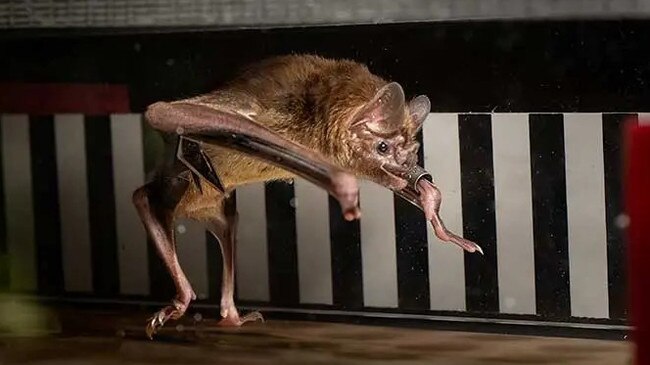Vampire bats hit the treadmill in blood-to-energy experiment
By making the mammals run, researchers have found that they transform blood into energy in a matter of minutes, just like some insects.

You would be forgiven for thinking that the common vampire bat mainly poses an airborne threat and that if you ever spotted one approaching, you could try to swat it away.
But according to scientists, the species is far more stealthy than this. It is, they say, a “capable runner” and a furtive one. Its ability to scuttle along the ground, on its legs and folded wings, allows it to sneak up on cattle and other prey, which have sometimes included sleeping humans. After this silent approach, it will use its razor-sharp teeth to make a small, painless incision.
How it processed its food had been something of a mystery. But researchers have now shed light on how the species rapidly draws energy from the blood it laps up. They designed an experiment that involved getting several bats to spend more than an hour running on a treadmill.
Vampire bats are the only mammals that rely exclusively on the blood of other animals for their nutrition. The research revealed that to survive on this diet, they rely on an unusual method of extracting energy from the protein it contains.
Researchers at the University of Toronto first captured two dozen adult common vampire bats in Belize, Central America.
The animals were taken to a laboratory and fed on cows’ blood that had been enriched with two amino acids, which are the building blocks of proteins. These contained isotopes of carbon that acted as chemical markers. The bats were placed on a treadmill in a sealed plastic box. This allowed the researchers to track how much oxygen they were using and how much carbon dioxide they were exhaling, as they ran at speeds of up to about 1.7km/h.
Showing significant stamina, most of the bats kept moving for all of the 90-minute experiment.
After analysing the carbon isotopes in the exhaled breath, the researchers learnt that they were pulling energy from their recent blood meal, rather than relying on stored fats or sugars. The results indicate that proteins from the blood samples were responsible for as much as 60 per cent of the energy used by the bats as they scampered. In most mammals, running is fuelled by carbohydrates and lipids, while amino acids contribute less than 5-10 per cent of the energy used.
The researchers had seen a similar system for extracting energy from protein in the tsetse fly, a bug that also feeds on blood and is responsible for spreading sleeping sickness in Africa.
“We found vampire bats can fuel most of their running with amino acids in a blood meal eaten only minutes before, just like some insects,” said Kenneth Welch, of the University of Toronto, a co-author of the paper.
Michael Hiller, a researcher at the Loewe Centre for Translational Biodiversity Genomics in Frankfurt, who was not involved with the paper, told The New York Times that the ability to draw energy from amino acids in less than 10 minutes was “unparalleled in mammals”.
The results suggest vampire bats and blood-feeding insects extract energy from their food in similar ways. They would have developed this ability separately, a phenomenon known as convergent evolution.
The findings were published in the journal Biology Letters.
THE TIMES



To join the conversation, please log in. Don't have an account? Register
Join the conversation, you are commenting as Logout